Introduction: The Wonderful World of Retrograde Analysis
Chess is an endlessly rich resource for puzzles. The most typical type of chess puzzle shows a position on the board and asks the solver to find the best move or to force checkmate in a specified number of moves, working through the opponent’s most resilient defenses as well. We can divide these into two types: puzzles (or exercises) and problems. Puzzles or exercises tend to give positions from real chess games, or at least positions that resemble real chess games. People solve them to sharpen their tactical skills and improve their chess abilities. Problems, on the other hand, actually have very little to do with playing chess. Problem positions are usually highly unnatural and extremely unlikely to be achieved through normal play. Instead, problems are composed for aesthetic purposes. Maybe they demonstrate a particularly unusual checkmating pattern or the best move in the position looks like the weakest move you could play until you inspect the situation more deeply. Problems merely use the rules of chess to express something beautiful. My favorite traditional “White to play and force mate in x moves” problem is here, with a wonderful exposition to guide you through it.
My favorite genre of chess problems is retrograde analysis (shortened to “retros”). In traditional chess problems, you’re looking forward. Find the best sequence of moves to make you better off in the future than you are now. In retros, your job is to deduce something about the past. How did we arrive in this position? What were the last few moves? Does white still have the right to castle in this position? In chess gameplay, the past almost never matters. The position in front of you is the situation, and regardless of how you got there, you’re trying to find the best move. I find it astonishing that the rules of chess are rich and constraining enough that you can create static positions from which you can deduce all sorts of details about the past, even the distant past. Below is an instructive example problem from Raymond Smullyan’s delightful book of retros “The Chess Mysteries of Sherlock Holmes.”
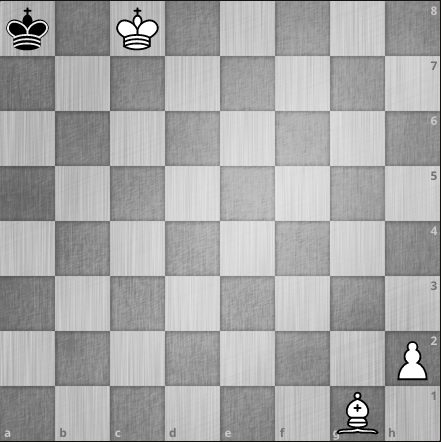
Since white is to play, black must have moved last. Black only has a king on the board so where did that king come from? It could not have come from squares b7 or b8 because this would result in the two kings being on adjacent squares, which is never legal in chess. So by process of elimination, the black king came from a7 on the last move. But notice that the black king is in check on this square from the bishop on g1. How did this check occur?
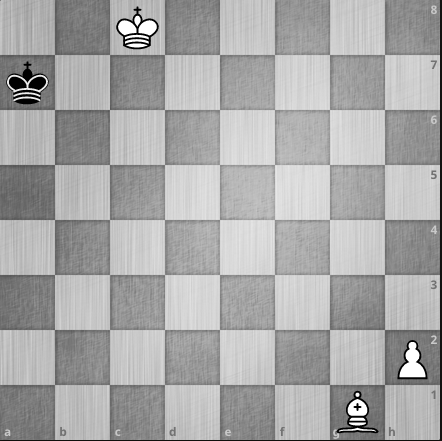
Whichever move white retracts (remember, we’re thinking backwards here) must relieve the black king of the check because checks in chess must be addressed immediately and cannot persist on the board for two consecutive moves. The bishop could not have come from h2 because the white pawn is occupying that square. And if it came from any square along the a7-g1 diagonal, the black king would have been in check already when white was making this move, which would be illegal.
So if the bishop didn’t move into its current square to deliver check, how else could the check have occurred? Some piece must have been blocking the a7-g1 diagonal and moved out of the way to unveil the check. Where is that piece in the original position though? The white king couldn’t have leapt to it’s current perch from that diagonal in one move. The phantom piece must have been captured by the black king when it moved to a8! Only one piece could have resided on the a7-g1 diagonal, blocking the attack from the bishop, and made it to a8 in one move to be captured by the black king: a white knight. So the beginning of the sequence looked like this:
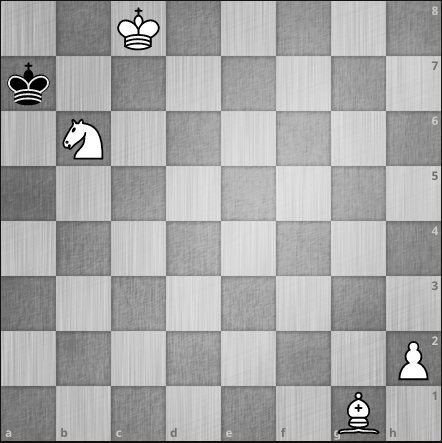
The white knight then moved to a8 to reveal a discovered check from the bishop. The black king then captured the knight on a8, which is the unique solution to the problem. No other sequence could have legally led to the original position with white to move. So from a static position, we were able to deduce that a knight was just captured even though there is no knight on the board! This is a tiny glimpse into the vast magic of retrograde analysis. The constructions that people have managed to compose in this genre are absolutely staggering and hit me right in my aesthetic center.
I have published three chess problems. Two are retros and one is a “construction task,” where the solver has to create a position with certain properties. The first retro is possibly my proudest achievement ever. This is pretty ridiculous because it is a sub-genre of a sub-genre of a niche that at most a few dozen people will care about, but to me it’s truly beautiful.
Problem 1: Chess960 and My Proudest Creation
Bobby Fischer, one of the greatest chess players to ever live, thought that opening preparation was taking over competitive chess. Since chess games always begin with the pieces in the same orientation, people pour enormous resources into studying the optimal ways to begin a game, memorizing hundreds of sequences of 20 or even 30 moves. Fischer believed that the status quo rewards players who study the most over players who are the most talented. To rectify this, Fischer proposed a variant of the game called Chess960 (also known as Fischer random chess). Chess960 has the same rules, except each player’s back row of pieces begins the game in a random configuration (the pawns begin on the same squares as usual). This makes it much harder to prepare for games because players have no idea what the starting position will be, and so strategy, intuition, and calculation ability become the primary factors from move one. While Chess960 has not replaced traditional chess as Fischer hoped, there are regular tournaments in the variant at the highest competitive levels.
Chess960 is so named because randomly permuting the pieces (with some additional constraints outlined below) results in 960 different possible starting positions. Since retro problems are all about uncovering the past, and you cannot go farther back than move one, I always thought a cool premise for a retro would be deducing which of the 960 possible starting positions gave rise to a given position that may be many moves deep into a game. One day I set off to create such a position and became obsessed. For two weeks, I would pour a cup of coffee first thing in the morning, sit down at the chess board, and work until 1 am when my eyes were falling out. I’d get into bed and pull the position up on my phone and continue tinkering until I fell asleep. Then I’d repeat the next day, all while not even knowing if my goal was possible in principle, let alone in practice. Finally, I created this:
The Problemist, 2021
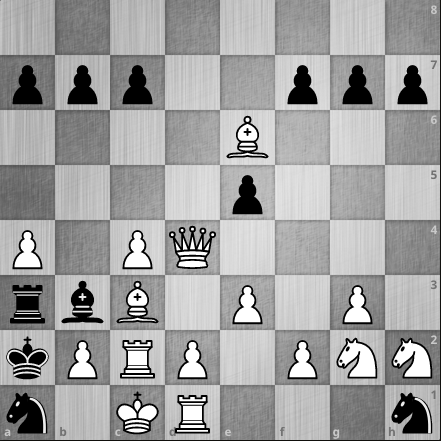
Anybody who plays chess (and possibly some who don’t) will recognize that the diagram shows a highly unnatural arrangement of the pieces. This is normal for chess problems. What matters is that this position, while ~40 moves deep, can only be reached by one of the 960 starting Fischer random positions through legal (again, unnatural but legal) play. Furthermore, there are enough clues hidden in the position to deduce which one. It is exactly what I set out to do and I could not be happier with the final product. Solving this takes some doing and I wouldn’t recommend it to anyone who hasn’t already solved a fair number of retro problems. For anyone who wants to attempt it, some important notes about Chess960 are below* (or see the Wikipedia page). Feel free to email me if you’d like to know the solution.
The problem was awarded 1st honorable mention in the 2021-2022 Problemist retro tourney (fourth place out of the problems published in that two year period). The judge wrote,
*Rules of Chess960:
- The starting position will be the same for both sides (i.e. if the white king begins on f2, then the black king will begin on f8 and a white bishop on b2 means a black bishop on b8, etc.) The pawns all begin on the 2nd and 7th ranks as usual.
- Each side must have a light-squared bishop and a dark-squared bishop.
- The king must begin somewhere between the two rooks. This is to allow “a-side” castling and “h-side” castling as described below. This rule means, for example, that two rooks cannot begin next to each other.
- Just as in usual chess, castling can only occur if the king and relevant rook have never moved, all of the squares the pieces pass through are cleared, and none of the squares the king passes through are under attack. When castling h-side (toward the rightmost rook for white), the king and rook end on the same squares as kingside castling in regular chess (f-file and g-file) regardless of where they began. Likewise, when castling a-side, the king and rook end on the same squares as regular queenside castling.
Problem 2: A Lighter Challenge
My second retro is based on the usual rules of chess (not Chess960).
Die Schwalbe, 2022
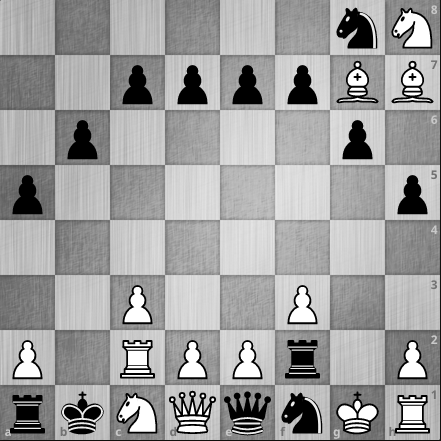
In this position, black has no dark-squared bishop on the board and the solver’s task is to figure out where it perished. The symmetry in this position makes it instantly attractive to me. When you begin solving it, you come upon four possible storylines for how the depicted knot came to be and the little asymmetry in the northeast corner holds the key for determining which one actually took place. This problem is much more approachable than the Chess960 one but will still be difficult if you have no exposure to this medium. Again, I welcome emails from those who want to know the solution.
Problem 3: A Construction Task
In chess, a stalemate occurs when the side to move has no legal moves. This results in an instant draw even if the side with no moves has an inferior position. I became curious about situations where black has lots of legal moves available to them and yet after only one move from each side, black is stalemated. In other words, could one go from a maximal number of legal moves to a minimal number of legal moves in a very short amount of time? To constrain the search space a bit, I limited the number and variety of pieces that black could have and found the following:
Die Schwalbe, 2021
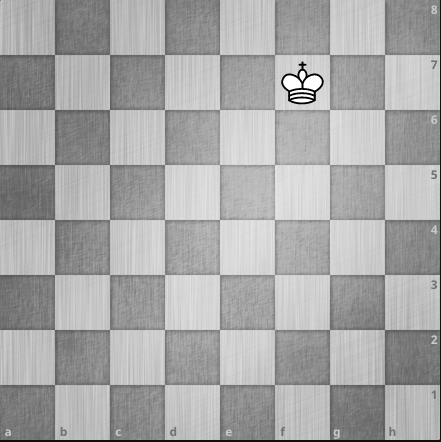
By “minimal white force” I mean make the white pieces you add have as little total point value as possible (with the usual convention that pawns are worth 1 point, knights=3, bishops=3, rooks=5, and queens=9). The restriction “four different black pieces” must include a black king in order for the resulting position to be legal. The white king is already placed on the board largely to preclude solutions that are simply rotations or translations of the intended solution. In the solution, black and white are cooperating with their moves to force the stalemate.
One thing that’s great about the chess composition community is that if you introduce an interesting theme that nobody has explored before, other people will work on it and try to improve your construction. That’s exactly what happened here. My intended solution was:
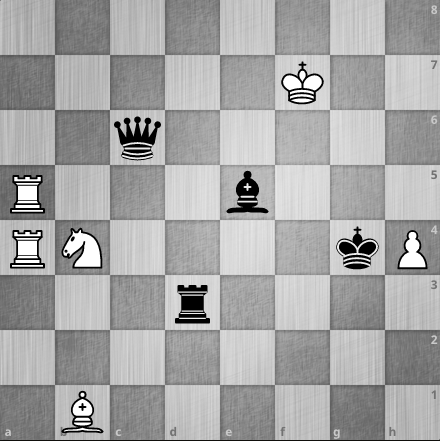
Black has four different pieces on the board and it can be verified that they have 59 legal moves in the position. But after black plays king to f5 and white plays knight takes queen on c6, black has zero legal moves!
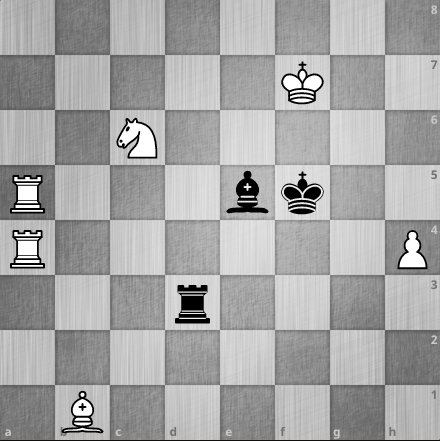
I thought there was a chance that this solution was optimal but I couldn’t prove it. Then two people wrote in to Die Schwalbe magazine and improved my construction. The first person managed to remove one point of force from the white side:
Boris Tummes
Die Schwalbe, 2021
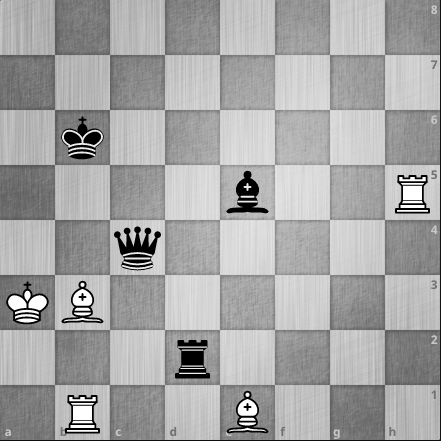
Black has 59 legal moves but after black moves king to a5 and white responds with taking black’s queen with their bishop, black is in stalemate. My position used two rooks, a knight, a bishop, and a pawn, whereas this swaps the knight for a bishop (pieces of equal value) and drops the pawn! Boris moved the white king from where it was in my prompt diagram, but that doesn’t matter as it doesn’t affect the spirit of the problem.
I had thought that the largest number of moves a side could have with four different pieces on the board was 60 and Boris and I were able create positions that only deprived black of one of these. Clearly (so I thought) the four different black pieces had to be a king, queen, rook, and bishop. Either the queen or the bishop must occupy a central square to maximize its scope but not both of them because they’d trip over each other. Swapping any of these pieces for a knight wouldn’t make sense because knights can only have a maximum of 8 moves while bishops, rooks, and queens have the potential to control more than 8 squares. Then Ulrich Voigt pointed out that I had made a major oversight and in fact it was possible for black to have four different pieces and 61 legal moves if we swapped out the bishop for a pawn!
Ulrich Voigt
Die Schwalbe 2021

In this position black has 60 legal moves because the pawn on d2 can capture either rook or step forward one square and on each of these three possibilities, it can promote to any of four different pieces, for a total of 12 moves. I had disregarded pawns thinking they could have a maximum of 4 moves because I overlooked different promotions counting as different moves. When black moves the king to f2 and white responds with bishop takes queen on e4, black is stalemated. A magnificent idea by Mr. Voigt.
This isn’t the end of the road for this “maximum moves to minimum moves” theme. Perhaps the construction above can be improved to use less white force or to allow black a full 61 moves in the starting position. Dropping the constraint of only giving black four different pieces is also unexplored territory as far as I know. What is the maximum number of moves black could have with a stalemate in one lurking around the corner?